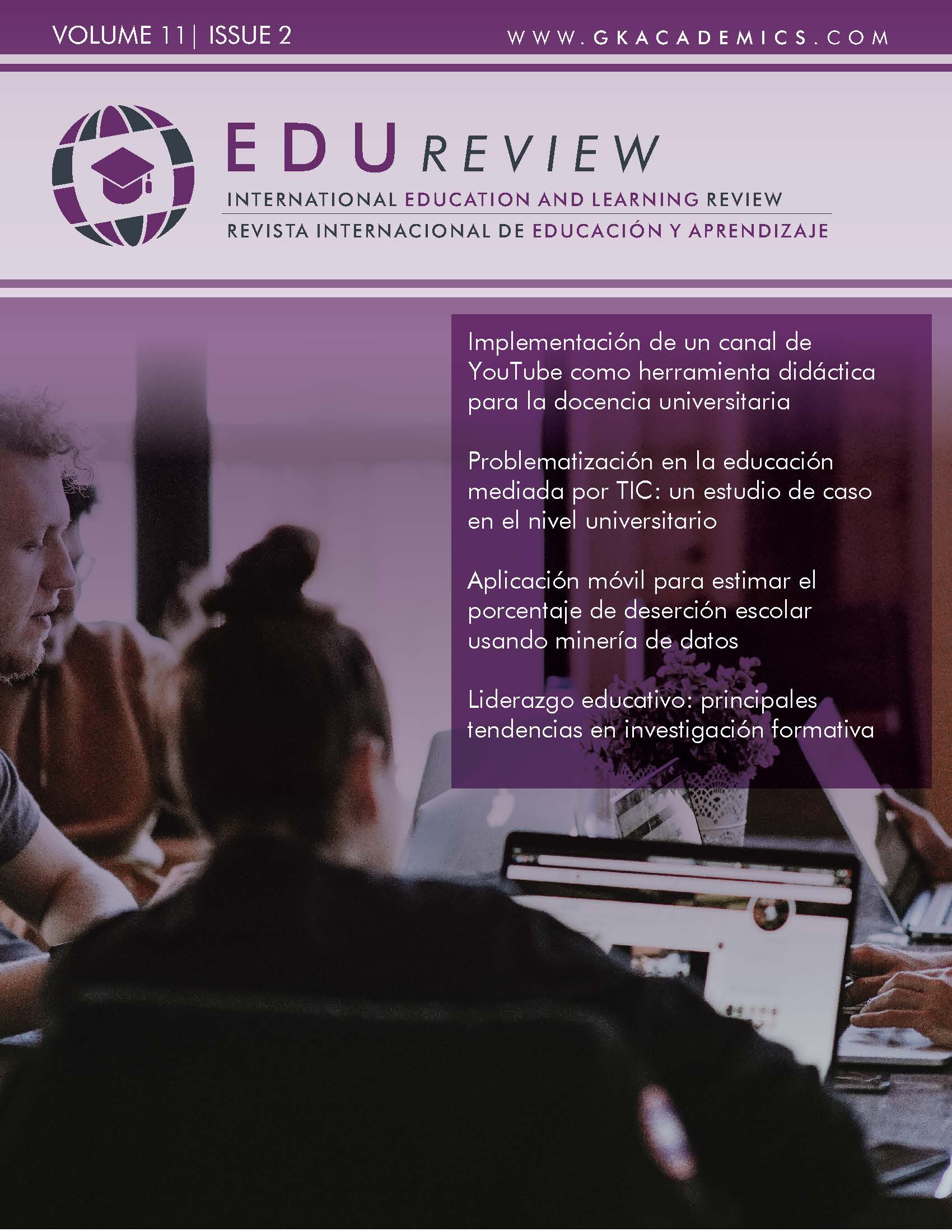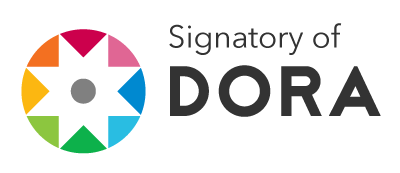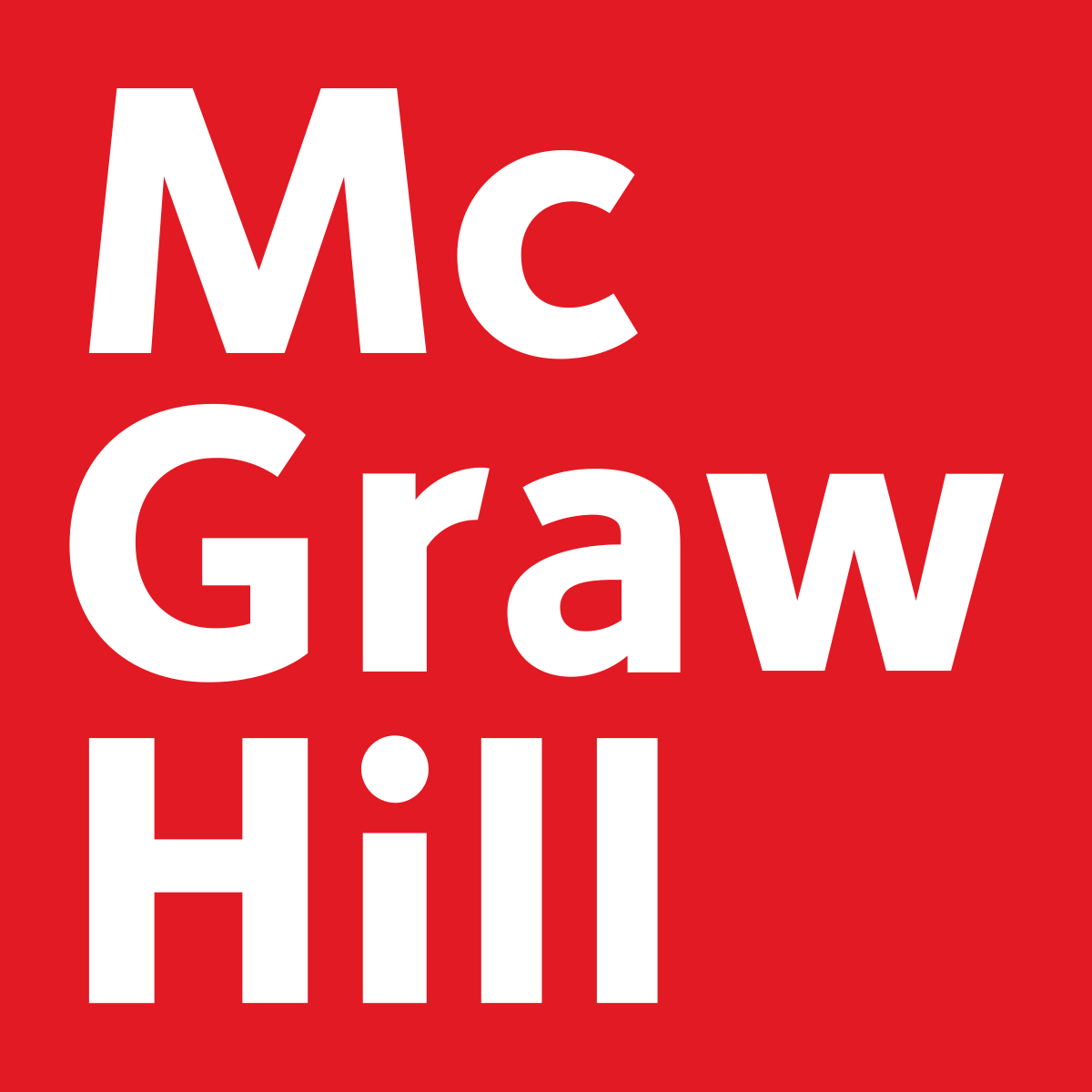Implementation of Technological Tools Teaching Probability and Statistics: Systematic Review
DOI:
https://doi.org/10.37467/revedu.v11.5003Keywords:
Systematic Review of Literature, Teaching, Technology, Probability, StatisticsAbstract
This paper analyses how technological tools are implemented and what impact they have on teaching of Probability and Statistics at secondary school onwards. A Systematic Review of Literature was conducted in order to obtain qualitative and quantitative data on reported research. It is highlighted that implementation of information and communication technology (ICT) educational tools in Probability and Statistics allows to know and explore the applications and thus deepen the learning of these topics, which would generate a desirable statistical culture for everyday situations.
Downloads
Global Statistics ℹ️
|
1098
Views
|
348
Downloads
|
|
1446
Total
|
|
References
Alexander, D., Piratova, Q., Educativa, I., Darío, D., México, E., Georgina, M., Zermeño, G., y Monterrey, T. De. (2015). Mejora de la enseñanza de la Estadística mediante la implementación de una Comunidad Virtual de Aprendizaje. 73–87.
Alpízar Vargas, M., Barrantes Quirós, J. P., Bolaños González, H., Céspedes López, M., Delgado Carvajal, E., Freer Paniagua, D., Padilla Mora, E. R., y Víquez Ortiz, M. F. (2012). Aspectos relevantes sobre la formación docente en I y II ciclos en los temas probabilidad y estadística. Revista Electrónica Educare, 16(2), 113–129. https://doi.org/10.15359/ree.16-2.7 DOI: https://doi.org/10.15359/ree.16-2.7
Araújo, A. F. Q., y Carvalho, J. I. F. de. (2021). Conhecimentos Didático-Matemáticos para Abordagem da Curva Normal no Ensino Médio. Jornal Internacional de Estudos em Educação Matemática, 13(4), 450–460. https://doi.org/10.17921/2176-5634.2020v13n4p450-460 DOI: https://doi.org/10.17921/2176-5634.2020v13n4p450-460
Bakogianni, D., y Potari, D. (2019). Re-sourcing secondary mathematics teachers’ teaching of statistics in the context of a community of practice. The Journal of Mathematical Behavior, 56, 100699. https://doi.org/10.1016/j.jmathb.2019.03.006 DOI: https://doi.org/10.1016/j.jmathb.2019.03.006
Batanero, C. (2004). Los retos de la cultura estadística. En Yupana (Vol. 4, Número 1, pp. 27–37). DOI: https://doi.org/10.14409/yu.v1i1.238
Batanero, C. (2009). Retos para la formación estadística de los profesores. Angewandte Chemie International Edition, 6(11), 951–952., Actas do I, 7–21.
Batanero, C., y Arteaga, P. (2011). El Currículo De Estadística En La Enseñanza Obligatoria. Em Teia| Revista de Educação Matemática e Tecnológica Iberoamericana-ISSN: 2177-9309, 2(2), 1–20. https://doi.org/10.36397/emteia.v2i2.2151
Batanero, C., y Godino, J. D. (2005). Perspectivas de la educación estadística como área de investigación. Líneas de investigación en Didáctica de las Matemáticas, 203–226.
Cantú Martínez, P. C., y Santoyo Stephano, M. A. (2019). Evaluación del rendimiento académico en bioestadística y la competencia disciplinar de pensamiento matemático en estudiantes universitarios TT - Evaluation of the academic performance in Biostatistics and the disciplinary competence of mathematical think. Educación, 28(54), 45–60. https://doi.org/10.18800/educacion.201901.003 DOI: https://doi.org/10.18800/educacion.201901.003
Cruz-García, C., Silva-Rodríguez, A., Guarneros-Reyes, E., Espinoza-Zepeda, A. J., Sánchez-Medina, R., y Enriquez-Negrete, D. J. (2019). Sistema de evaluación del aprendizaje de un curso en línea autogestivo de estadística para universitarios. Revista Digital Internacional de Psicología y Ciencia Social, 5(2), 238–258. https://doi.org/10.22402/j.rdipycs.unam.5.2.2019.167.238-258 DOI: https://doi.org/10.22402/j.rdipycs.unam.5.2.2019.167.238-258
Cuevas, H., y Ramírez, G. (2018). Desempeño en estocástica entre profesores de educación secundaria: un estudio exploratorio en dos regiones de Costa Rica y México TT - Performance in Stochastic between Secondary School Teachers: An Exploratory Study in Two Regions of Costa Rica and Mexi. Educación matemática, 30(1), 93–132. https://doi.org/10.24844/em3001.04 DOI: https://doi.org/10.24844/EM3001.04
Esponda, D. C., Crespo, Y. A., Quintana, Y. G., y Vera, D. A. Z. (2017). La contribución de la Estadística en la formación del profesional agropecuario, agroindustrial y forestal. Revista Electronica de Veterinaria, 18(5), 1–9.
Estrada, A., Batanero Bernabeu, C., y Fortuny Aymemí, J. M. (2004). Un estudio comparado de las actitudes hacia la estadística en profesores en formación y en ejercicio. Enseñanza de las Ciencias. Revista de investigación y experiencias didácticas, 22(2), 263. https://doi.org/10.5565/rev/ensciencias.3888 DOI: https://doi.org/10.5565/rev/ensciencias.3888
Fernandes, J. A., Gea, M. M., y Diniz, L. do N. (2019). Tarefas propostas por futuros professores dos primeiros anos para ensinar probabilidades. Revista Brasileira de Educação, 24. https://doi.org/10.1590/s1413-24782019240039 DOI: https://doi.org/10.1590/s1413-24782019240039
Ferrando Palomares, I., Hurtado Soler, D., y Beltrán Meneu, M. J. (2018). Formación STEM en el grado de maestro: una experiencia docente. @tic. revista d’innovació educativa, 20, 35. https://doi.org/10.7203/attic.20.10946 DOI: https://doi.org/10.7203/attic.20.10946
Ferreira González, I., Urrútia, G., y Alonso-Coello, P. (2011). Systematic reviews and meta-analysis: Scientific rationale and interpretation. Revista Espanola de Cardiologia, 64(8), 688–696. https://doi.org/10.1016/j.recesp.2011.03.029 DOI: https://doi.org/10.1016/j.rec.2011.03.027
García-Carro, B., y Sánchez-Sellero, M. C. (2018). ¿Ha cambiado el Plan Bolonia los resultados académicos en las asignaturas de estadística? Innovar, 28(67), 137–146. https://doi.org/10.15446/innovar.v28n67.68619 DOI: https://doi.org/10.15446/innovar.v28n67.68619
Godino, J. D. (2002). La formación matemática y didáctica de maestros como campo de acción e investigación para la didáctica de las matemáticas: el proyecto Edumat-Maestros. V simposio sobre aportaciones del área didáctica de la Matemática a diferentes perfiles profesionales. Universidad de Alicante, España., 8(5), 55.
Godino, J. D., Batanero, C., y Wilhelmi, M. R. (2008). Assessing and developing pedagogical content and statistical. Joint ICMI/IASE study: teaching statistics in school mathematics. Challenges for teaching and teacher education. Proceedings of the ICMI study, 18.
Inzunza Cazares, S. (2017). Potencial de los proyectos para desarrollar motivación, competencias de razonamiento y pensamiento estadístico TT - Potential of the projects to developing motivation, competences of reasoning and statistical thinking. Actualidades Investigativas en Educación, 17(3), 458–488. https://doi.org/10.15517/aie.v17i3.29874 DOI: https://doi.org/10.15517/aie.v17i3.29874
Jiroutek, M. R., Kim, M., Hayat, M. J., Taylor, M. N., y Schwartz, T. A. (2019). A cross-sectional assessment of statistical knowledge among pharmacy faculty. Currents in Pharmacy Teaching and Learning, 11(8), 793–801. https://doi.org/10.1016/j.cptl.2019.04.007 DOI: https://doi.org/10.1016/j.cptl.2019.04.007
Linares-Espinós, E., Hernández, V., Domínguez-Escrig, J. L., Fernández-Pello, S., Hevia, V., Mayor, J., Padilla-Fernández, B., y Ribal, M. J. (2018). Metodología de una revisión sistemática. Actas Urológicas Españolas, 1–8. DOI: https://doi.org/10.1016/j.acuro.2018.01.010
López, G. M., y Soto Urrea, W. H. (2019). Pedagogía del dato: perspectiva desde la enseñanza de la estadística en la sociedad del dato. Análisis, 51(94 (EN-JU)), 141–158. https://doi.org/10.15332/s0120-8454.2019.0094.07 DOI: https://doi.org/10.15332/s0120-8454.2019.0094.07
Ma, Y., y Qin, X. (2021). Measurement invariance of information, communication and technology (ICT) engagement and its relationship with student academic literacy: Evidence from PISA 2018. Studies in Educational Evaluation, 68, 100982. https://doi.org/https://doi.org/10.1016/j.stueduc.2021.100982 DOI: https://doi.org/10.1016/j.stueduc.2021.100982
Malaspina, M., y Malaspina, U. (2020). Game Invention as Means to Stimulate Probabilistic Thinking. Statistics Education Research Journal (Vol. 19, Número 1, pp. 57–72). DOI: https://doi.org/10.52041/serj.v19i1.119
Manterola, C., Astudillo, P., Arias, E., y Claros, N. (2013). Revisiones sistemáticas de la literatura. Qué se debe saber acerca de ellas. Cirugia Espanola, 91(3), 149–155. https://doi.org/10.1016/j.ciresp.2011.07.009 DOI: https://doi.org/10.1016/j.ciresp.2011.07.009
Moher, D., Liberati, A., Tetzlaff, J., y Altman, D. G. (2010). Preferred reporting items for systematic reviews and meta-analyses: The PRISMA statement. International Journal of Surgery, 8(5), 336–341. https://doi.org/10.1016/j.ijsu.2010.02.007 DOI: https://doi.org/10.1016/j.ijsu.2010.02.007
Moral de la Rubia, J., González Ramírez, M. T., Landero Hernández, R., y Quezada Berumen, L. D. C. (2020). Validación del modelo de cinco factores de la Escala de Actitud hacia la Estadística en estudiantes mexicanos de psicología. Interdisciplinaria Revista de Psicología y Ciencias Afines, 38(1), 133–148. https://doi.org/10.16888/interd.2021.38.1.9 DOI: https://doi.org/10.16888/interd.2021.38.1.9
Page, M. J., y Moher, D. (2017). Evaluations of the uptake and impact of the Preferred Reporting Items for Systematic reviews and Meta-Analyses (PRISMA) Statement and extensions: a scoping review. Systematic reviews, 6(1), 1-14. DOI: https://doi.org/10.1186/s13643-017-0663-8
Rivas Catricheo, H., Godino, J. D., y Arteaga Cezón, P. (2019). Los proyectos como contextualizadores de nociones básicas de estadística y probabilidad en la formación inicial de profesores de educación primaria. Estudios pedagógicos (Valdivia), 45(1), 41–59. http://dx.doi.org/10.4067/S0718-07052019000100041 DOI: https://doi.org/10.4067/S0718-07052019000100041
Roldán-López, A. F., Batanero, C., y Alvarez-Arroyo, R. (2020). Conflictos semióticos relacionados con el intervalo de confianza en estudiantes de Bachillerato e Ingeniería. Educação Matemática Debate, 4, e202010. https://doi.org/10.24116/emd.e202010 DOI: https://doi.org/10.24116/emd.e202010
Ruíz Hernández, B., Inzunsa Cázares, S., Huerta, A. A., Domínguez Domínguez, J., Hernández González, S., y Zacarías Flores, J. D. (2015). Uso de la tecnología en la enseñanza de la probabilidad y estadística. Memoria de la XVII Escuela de Invierno en Matemática Educativa. La Profesionalización Docente desde los Posgrados de Calidad en Matemática Educativa, 399–410.
Ruiz Ledesma, E. F. (2018). Empleo de aplicaciones tecnológicas en el tratamiento de temas de Probabilidad y Estadística. Dificultades presentadas por los estudiantes en la formulación de planteamientos correctos TT - Use of technological applications in the treatment of Probabilit. RIDE. Revista Iberoamericana para la Investigación y el Desarrollo Educativo, 8(16), 216–245. https://doi.org/10.23913/ride.v8i16.339 DOI: https://doi.org/10.23913/ride.v8i16.339
Sánchez, E. (2009). La probabilidad en el programa de estudio de matemáticas de la secundaria en México. Educación matemática, 21(2), 39–77.
Soto-Hernández, D., Valencia, O., y Moyado, S. (2020). Brecha digital y actividad económica : el caso de las mujeres indígenas en la Sierra Sur de Oaxaca , México. Revista CTS, 15(45), 209–238.
Vásquez Ortiz, C., Alvarado Martínez, H., y Ruz, F. (2019). Actitudes de futuras maestras de educación infantil hacia la estadística, la probabilidad y su enseñanza TT - Attitudes of future teachers of childhood education towards statistics, probability and its teaching. Educación matemática, 31(3), 177–202. https://doi.org/10.24844/em3103.07
Downloads
Published
How to Cite
Issue
Section
License
Those authors who publish in this journal accept the following terms:
-
Authors retain copyright.
-
Authors transfer to the journal the right of first publication. The journal also owns the publishing rights.
-
All published contents are governed by an Attribution-NoDerivatives 4.0 International License.
Access the informative version and legal text of the license. By virtue of this, third parties are allowed to use what is published as long as they mention the authorship of the work and the first publication in this journal. If you transform the material, you may not distribute the modified work. -
Authors may make other independent and additional contractual arrangements for non-exclusive distribution of the version of the article published in this journal (e.g., inclusion in an institutional repository or publication in a book) as long as they clearly indicate that the work was first published in this journal.
- Authors are allowed and recommended to publish their work on the Internet (for example on institutional and personal websites), following the publication of, and referencing the journal, as this could lead to constructive exchanges and a more extensive and quick circulation of published works (see The Effect of Open Access).













